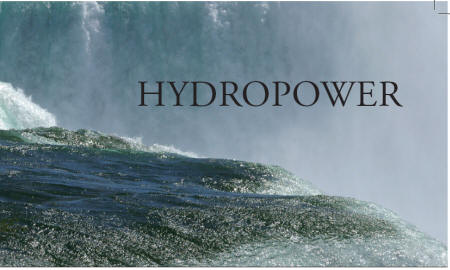
Water is constantly moving through a vast global cycle, evaporating from lakes and oceans, forming clouds, precipitating, and then flowing back into the ocean. The energy of this water cycle, which is mainly driven by the sun, can be tapped to produce electricity or to power machines—a process called hydropower. Hydropower uses water as a type of fuel that is neither reduced nor used up in the process. Since the water cycle is endless and will constantly recharge the system, hydropower is considered a renewable energy.
Hydropower (also known as hydroelectric power) is made when flowing water is captured and turned into electricity. There are many types of hydroelectric facilities that are all powered by the kinetic energy derived from flowing water as it moves downstream. Generators and turbines convert this energy into electricity. This is then fed into the electrical grid for use in homes, businesses, and other industries.
Water’s never ending cycle.
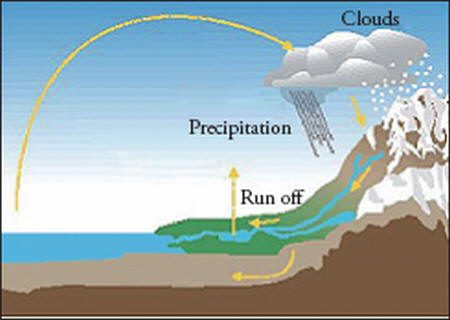
A Brief History of Hydropower
Humans have been using water to help them perform work for thousands of years. Water wheels have been employed for grinding grains into flour, to saw wood, and to power textile mills. The technology to use running water to create hydroelectricity has been around for over a hundred years. The modern hydropower turbine was created in the middle of the eighteenth century and developed into direct current technology. Today, an alternating current is in use and came about when the electric generator was combined with the turbine. The first hydroelectric plant in the United States was built in Appleton, Wisconsin in 1882.
Types of Hydropower Plants
There are three types of hydropower plants:
1. Impoundment—impoundment facilities are the most common type of hydroelectric power plants. This facility, typically a large hydropower system, uses a dam to store river water in a reservoir. Water that is released from the reservoir flows through a turbine, spinning it. This activates a generator to produce electricity. The water may be released either to meet the changing electricity needs or to maintain a constant reservoir level.
2. Diversion—A diversion facility, sometimes referred to as a run-of-river facility, channels a portion of a river through a canal or penstock. This does not always require the use of a dam.
3. Pumped storage—A pumped storage facility stores energy by pumping water from a lower reservoir to an upper reservoir when electricity demands are low. During times when electrical demands are high, water is then released back into the lower reservoir to generate electricity.
Some hydropower plants use dams and others do not. Many dams were originally built for other purposes and then hydropower was added at a later date. In the United States, only 2,400 of the 80,000 dams produce power—the rest are used for recreation, farm ponds, flood control, water supply, and irrigation.
Diagram of a hydropower plant.
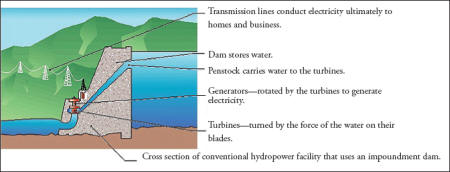
Size of Hydropower Plants
Hydropower plants range in size from small and micro systems, which are operated for individual needs or to sell the power to utilities, to larger projects that produce electricity for utilities, supplying many consumers with electricity.
Micro hydropower plants have a capacity of up to 100 kilowatts. Small hydropower plants have a capacity between 100 kilowatts and 30 megawatts. Large hydropower plants have a capacity of more than 30 megawatts. The small and micro systems can produce enough electricity for a home, farm, or even a small village.
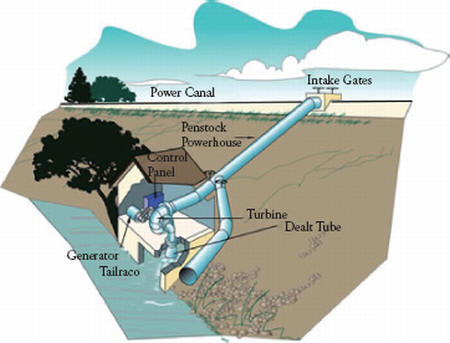
A micro hydropower plant.
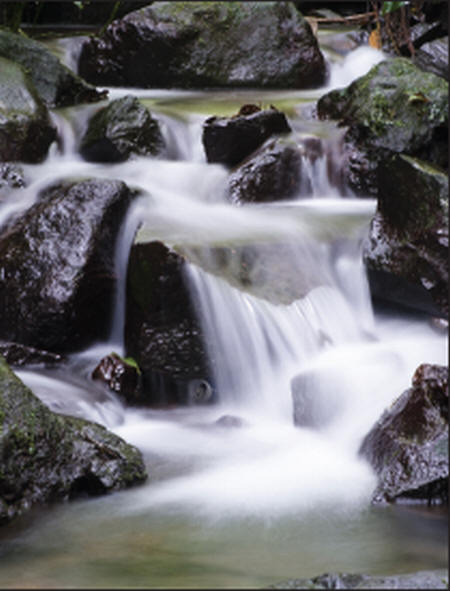
Even a small waterfall can provide a lot of power.
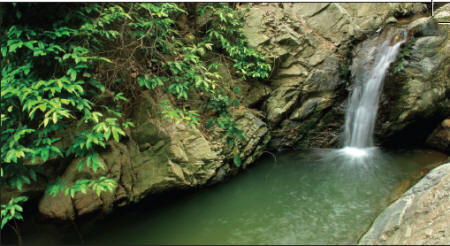
Hydropower Turbines
There are two main types of hydropower turbines: impulse and reaction. The type of turbine selected for a project is based on the height of the standing water (the “head”) and the flow (volume) of the water at a particular site. It is also determined by how deep the turbine must be set, its efficiency, and its cost.
Impulse Turbine
An impulse turbine typically uses the velocity of water to move the runner and discharges to atmospheric pressure. The water stream then hits each bucket on the runner. The water flows out of the bottom of the turbine after hitting the runner. These turbines are suitable for high head, low flow applications.
Reaction Turbine
A reaction turbine generates power by the combined action of pressure and moving water. The runner is placed in the water stream, which flows over the blades instead of striking each one separately. These turbines are used for sites with lower head and higher flows.
Diagram of a hydroelectric motor.
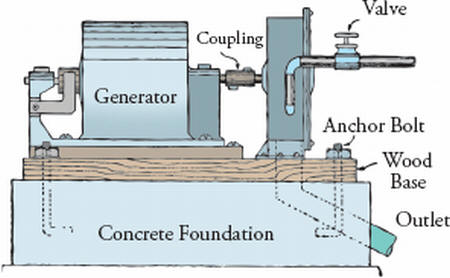
Advantages of Hydropower
• It is fueled by water, making it a clean energy source.
• It does not pollute the air since it does not burn any fossil fuels.
• It is a domestic energy source.
• It relies on the water cycle and is a renewable energy source.
• It is usually available as needed.
• The water flow can be controlled through the turbine to produce energy on demand.
• The plants provide reservoirs for recreation (fishing, swimming, boating), water supply, and food control.
Disadvantages of Hydropower
• It can negatively impact fish populations by hampering fish migration upstream past dams, though there are ways to allow for passage both up- and downstream.
• It can impact the quality and flow of water, causing low dissolved oxygen levels that can negatively impact the riverbank habitats.
• The plants can be impacted by drought, and if they are not receiving adequate water, they cannot produce electricity.
• The plants compete for land use and can cause humans, plants, and animals to lose their natural habitat.